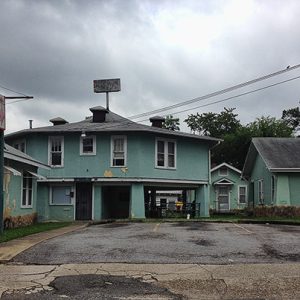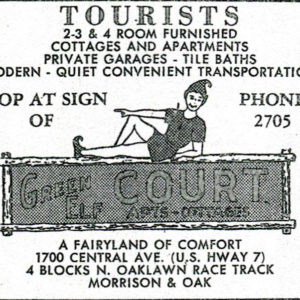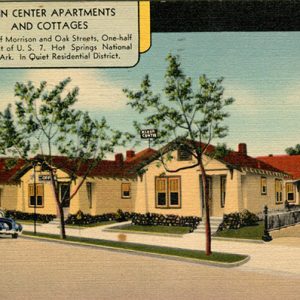calsfoundation@cals.org
George Klein Tourist Court Historic District
aka: Klein Center
aka: Racheau Center
aka: Green Elf Court
The George Klein Tourist Court Historic District at 501 Morrison Avenue in Hot Springs (Garland County) is a well-preserved example of Craftsman-style roadside lodging. Built by 1939 as a tourist court and apartments consisting of seven bungalows around an octagonal two-story office building, it later became the Green Elf Court Apartments. The district was added to the National Register of Historic Places on June 8, 1993.
Hot Springs was an established resort town before the Civil War because of the widespread belief that the hot springs had medicinal qualities. The first bathhouses predated the federal government reserving the land around the springs in 1832. Access to the area increased over time, first via a narrow-gauge railway from Malvern (Hot Spring County) built in 1875, and later with the advent of the age of the automobile and improved roads. By the early 1960s, the peak time for locally owned lodgings across the country, Hot Springs had the greatest number of tourist courts and motels in Arkansas by a large margin, and more than double the number in Little Rock (Pulaski County).
Visitors to Hot Springs came for the baths as well as other activities, among them betting on horse races. Oaklawn Park Racetrack (now Oaklawn Racing Casino Resort) opened in 1905, and after years of back and forth, in 1935, the Arkansas General Assembly declared pari-mutuel betting on horse races to be legal. George Klein built the Klein Center a few years later, less than one mile from the entrance to Oaklawn. The first public record of the Klein Center is in the February 1939 Hot Springs Telephone Directory. Postcards from the time give the fuller name of Klein Center Apartments and Cottages.
By 1944, the court had changed hands, and the new owner, Mitchell O. Racheau, renamed it Racheau Center. Within a year of selling the court, George Klein built the Klein Short Cottages on nearby Lake Hamilton, where he and his wife, Clara, resided. Also known as Klein Shore Resort, it continues as individually owned cottages, many of them renovated and for rent by their owners seasonally. Clara Klein died in 1967, and George died less than nine months later.
By February 1950, Nicholas Elfter had bought the court from Racheau for his home and business, and he held a contest to rename it. Perhaps inspired by the first syllable of the new owner’s last name, Kittie Thornton’s suggestion, “Green Elf Court,” won the contest, and Elfter renamed the court accordingly. Its new advertisement campaign featured a green elf and described the court as a “fairyland of comfort.” Nicholas Elfter died in 1956, and his widow, Anna Elfter, continued to live at the court and manage it until 1974. The Reverend David S. Witwer became the new owner and on-site manager. By 1984, Witwer had moved to Royal (Garland County) and was renting the Green Elf Court solely as apartments, as it is in the twenty-first century.
The most striking, and historically significant, feature of the George Klein Tourist Court Historic District is its architecture. The foundations of each of the seven bungalows are battered (meaning sloped) and faced with “grapevine” mortared fieldstone. Other Craftsman details include porches, exposed rafters, multiple gables, brackets, wide eaves, and Craftsman-style doors and windows. The one “airplane bungalow” is the most elaborate and sports a stone fireplace. The seven bungalows plus the central octagonal office building are all stucco structures painted a pale green, in keeping with the name Green Elf Court. Perhaps because of its residential environment, parking was never in front of each bungalow but instead in below-grade garages on the property.
Although most Americans know the word “bungalow” to mean the dominant housing type in the United States from about 1905 to 1930, the word itself comes from India and originally meant a structure built for travelers with a low roof and overhanging eaves, often with a veranda or porch. In the case of the Klein Center/Green Elf Court, this term came full circle. While the individual cabins of most tourist courts gave a slight nod to the homey and comforting image of a house, the “cabins” of this remarkable court appear to be full-size bungalow-style houses. Depending on its size, each bungalow originally consisted of from one to six rental units. If not for the grouping of eight bright-green structures, including the striking octagonal center building, and the “Green Elf Court” sign painted to match, the court would blend into its surrounding residential neighborhood almost seamlessly.
For additional information:
Balasco, Warren James. Americans on the Road: From Autocamp to Motel, 1910–1945. Baltimore, MD: Johns Hopkins University Press, 1979.
“George Klein Tourist Court Historic District.” National Register of Historic Places nomination form. On file at Arkansas Historic Preservation Program, Little Rock, Arkansas. Online at http://www.arkansaspreservation.com/National-Register-Listings/PDF/GA0481.nr.pdf (accessed October 1, 2020).
McLaren, Christie. “Arkansas Highway History and Architecture, 1910–1965.” Little Rock: Arkansas Historic Preservation Program, 1999. Online at http://www.arkansaspreservation.com/News-and-Events/publications (accessed October 1, 2020).
Jill Curran
Little Rock, Arkansas
 Business, Commerce, and Industry
Business, Commerce, and Industry Early Twentieth Century, 1901 through 1940
Early Twentieth Century, 1901 through 1940 Historic Preservation
Historic Preservation Green Elf Court Apartments
Green Elf Court Apartments  Green Elf Court Apartments
Green Elf Court Apartments  Green Elf Court Ad
Green Elf Court Ad  Klein Center Postcard
Klein Center Postcard 




Comments
No comments on this entry yet.